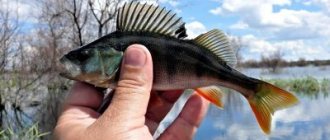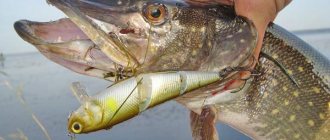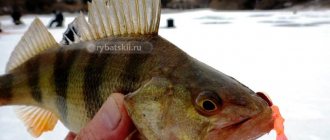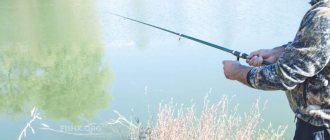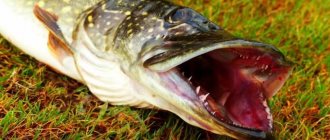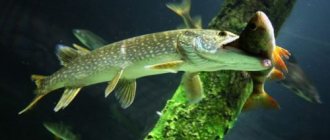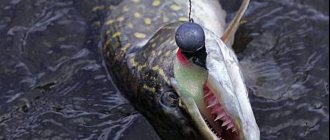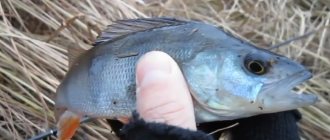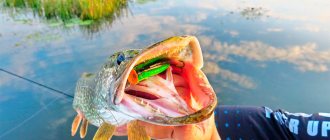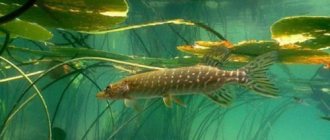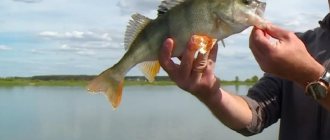Where to catch pike or perch using a spinning rod
To choose a spinning rod suitable for catching pike and perch, it is important to take into account the conditions in which you will be fishing and the expected size of the trophies. These predators are found in lakes, reservoirs and rivers. In the coastal zone, at depths of up to 3-4 m, predominantly small fish are found. For fishing in such places, light baits and spinning rods are used, which allow you to work with them comfortably. To look for perch and pike in the coastal zone you need to:
- in the bays;
- in thickets of grass and at their borders;
- in snags;
- on the edges;
- at the confluence of streams.
Large fish prefer to stay in the depths away from the shore. To fish here, you will need bait weighing up to 50 g and appropriate spinning rods. Suitable places for fishing would be:
- eyebrows;
- pits;
- underwater streamers;
- navels - rounded elevations at the bottom;
- snags.
The toothy predator is also often found in small ponds that become heavily overgrown in the summer - toad ponds. The main thing is to know how to fish in such conditions. It is necessary to use non-meshing installations and short wiring through free areas of water.
Rating of the best pike cranks
As you know, every predator has its own preferences. In most cases, catchy cranks for pike do not attract other fish well, although there are also universal wobblers.
When choosing crank wobblers for pike, you should focus primarily on proven models. You can find out about them by asking in a search engine the query “best cranks for pike” or “best cranks for pike fishing.”
Considering that the authors of different ratings have different preferences and different experiences, let’s try to create our own generalized top 10 cranks for pike, in which the model names are listed in random order:
- Ever Green Combat Crank 320. Operates at a depth of 3-4 m. When trolling, it dives up to 5 m. It has good flight qualities.
- Megabass Deep X-300. Deep-sea crankbait (up to 6 m), attracting not only pike, but also pike perch.
- Salmo Hornet is a fairly inexpensive universal wobbler. It comes in floating and sinking sizes from 2.5 to 7 cm. Works well for spring pike.
- Bomber Model A B04A. A crank that creates high-frequency vibrations with uniform wiring.
- Halco Sorcerer 68 is an original wobbler from an Australian company, equipped with replaceable blades for retrieving at different depths.
Excellent for fishing shallows or for fishing in shallow waters
- Yo-Zuri 3D Flat Crank is a small flat crank that works at a depth of up to 1.3 meters. Attracts small pike and perch, as well as chub.
- Owner C'ultiva Bug Eye Bait is a high-quality crank for catching medium-sized pike and perch at a depth of up to 1 m.
- Yo-zuri Hardcore Surface Crank. Excellent surface crank with a diving depth of 30 cm.
- The Rapala Shad Rap, 8 and 9 cm long, as well as the Super Shad Rap, 14 cm long, are timeless classics.
- Strike Pro Chubby Crank. A budget-friendly shallow-water wobbler 6 cm long that works well for pike, chub and perch.
Differences in catching predatory and peaceful fish using a spinning rod
Peaceful fish caught with spinning rods prefer small baits. Unlike pike and perch, due to the structure of its mouth, it is not capable of swallowing large prey. Therefore, to catch it you need spinning rods that allow you to cast and retrieve small spinners, silicone baits and wobblers.
Otherwise, there is no difference between catching predatory and peaceful fish using a spinning rod. When hunting with this gear for representatives of the underwater world, which are more often caught on a float rod or donk, the same techniques and techniques are used as when fishing for a predator.
Features of catching pike with wobblers - cranks
Let's look at the main aspects of fishing using cranks.
When, where and how best to catch them
These wobblers can be used to fish almost anywhere. However, we can highlight some places where stable fishing results are observed:
- oxbow lakes and places of rivers with minimal flow;
- areas of reservoirs with changing bottom topography;
- zone along the coastal seagrass line;
- reservoirs, ponds and other bodies of water where the current is weak or absent;
- branches, channels of large rivers.
It is better to fish with cranks along the terrain, where there are no underwater snags or mounds; for fishing, take a wobbler with a working depth of at least 2.5 meters. When fishing dumps, the boat is placed on the edge, bait is thrown in and passed along the dump. In snags, the crank should be buried no more than 1 meter, but if you know exactly where the snag is, then the wobbler should be placed next to it.
Spinning rod length
For hunting pike and perch, spinning rods ranging in size from 1.8 to 2.7 m are used. Long spinning rods are suitable for coastal fishing. They allow you to make long casts, reaching fish standing at a distance.
When fishing with a long spinning rod, it is convenient to maneuver the equipment, circling the islands of grass located in the water.
Short spinning rods are used when fishing from boats. A short spinning rod is convenient when fishing from a boat, and long casts are not required here. Another area of application for short spinning rods is fishing from a shore covered with forest or bushes. With a short rod it is convenient to move among the thickets and make casts from under overhanging branches.
Spinning test
Test - the recommended weight range of the baits used. According to this parameter, fishing rods can be divided into 5 classes.
| Ultralight spinning rods | up to 7 g |
| Light spinning rods | 5−15 g |
| Medium spinning rods | 10−30 g |
| Heavy spinning rods | 20−50 g |
| Super heavy spinning rod | more than 50 g |
For fishing for pike and perch, equipment weighing from 3 to 20 g is most often used. Spinning rod test for pike - from 5 to 40 g, depending on the expected size of the trophy.
Spinning rod structure
Three types of spinning rods are used for fishing for pike and perch:
- medium-fast action;
- fast formation;
- super-fast build.
The latter are characterized by maximum rigidity. They allow precise twitching of wobblers and provide the best sensitivity when fishing with jigs. Spinning rods of medium-fast action, in turn, due to their softness, tie up the fish, absorbing its jerks and preventing it from getting off the hook. They are well suited for hunting perch - this fish has weak lips that can tear when fishing.
Medium-fast spinning rods are used mainly for fishing that requires uniform retrieval. Fast action rods are a kind of golden mean. Such spinning rods are extremely versatile.
Coil selection
For hunting pike and perch, spinning reels are more often used. Their main advantages:
- ease of use;
- the ability to throw light equipment over long distances;
- a wide selection of affordable models, from which every spinning player will choose the appropriate option for himself.
The size of the reel for pike fishing is selected in such a way that it harmoniously combines with the spinning rod. The spool must hold at least 130 meters of main line of the required diameter.
Multiplier reels are also used. These models:
- have high traction characteristics;
- are highly durable;
- do not twist the line during wiring;
- provide maximum sensitivity of the spinning rod.
Multiplier reels are suitable for catching large fish with large baits that create strong resistance when retrieving. They are often used to hunt trophy toothy predators.
fishing line
Monofilament or braid is used as the main line. Transparent monofilament is less visible in water. It stretches well and thanks to this it absorbs the jerks of the fish when playing. Another advantage is its affordable price. But monofilament has significant disadvantages:
- due to its stretchability, it does not provide sensitivity to the equipment, so when fishing with it it is difficult to control the bait during retrieving;
- monofilament is superior in diameter to braided line of equal breaking load, so when fishing with it it is difficult to make long casts and to properly place the bait.
The main area of use of monofilament is catching perch with spinners and other baits that require uniform retrieval at close range. Vision plays an important role in perch hunting, so fishing with monofilament is more successful. The monofilament absorbs the jerks of the fish, preventing the weak lips of the perch from tearing.
But in most cases it is better to use braid. Its advantages:
- low elongation, thanks to which the cord provides maximum sensitivity of the spinning rod;
- small diameter with a high breaking load - due to this, the braid allows long casts and provides minimal resistance to water flow, making it convenient to retrieve baits when fishing on the river at great depths.
Braid is 10 times more expensive than monofilament, but it makes fishing comfortable and productive. A coil of cord will last for more than one season, so you shouldn’t waste money on buying it. Due to its low elongation, braiding almost does not absorb the jerks of the fish, so to fish with it you need to use a high-quality reel with a correctly adjusted drag.
To make leashes, use monofilament or fluorocarbon. The latter is a new type of fishing line. The refractive index of light in fluorocarbon is close to that of water, so such a thread is almost invisible in water. Another advantage is its rigidity. Fluorocarbon is very resistant to abrasion from rocks and shell rock lying on the bottom. A mandatory element of equipment for catching toothy fish is a metal leash, which protects the fishing line from being bitten.
How does perch help you catch pike?
It would seem, how can perch help catch pike? It turns out it can. Pike are always very partial to any actions of schooling perch. And this fact plays into the hands of pike fishermen. It is enough to choose the right place, which in the jargon of spinners is called a “penny”. This is usually the confluence of several streams of currents among two or three large islands of reeds or reeds. A backwater is formed in which several flows are mixed and several rarefaction zones are obtained. In these rarefaction zones there is a pike, and schools of perch, ide and other small predators move between the zones on the streams and nearby.
To lure pikes from their resting places in rarefaction zones, it is enough to arrange a “kipish” with the participation of the ubiquitous perch. We choose the most common perch popper and start fishing. Catching a perch in this type of fishing is not as important as perch exits, bites and misses. The gurgling of a popper, or better yet two or three, the fuss of a perch, the movement of a school, ultimately attracts the attention of a larger predator. And the “mother” comes out to see “who is disturbing the order here.” Continuing to catch perch with a popper, the angler suddenly notices a complete lack of bite from the “striped” robbers. This does not mean that the flock has moved away or moved away. Schools of perch never leave a place like “penny”. This means that the real owner of the “nickle” has taken the place of the general “fun”.
When catching perch with a popper, pike often come out “to hear the noise”
Continue to “gurgle” the popper further. After a couple or three strokes against the backdrop of complete calm, your popper gets into a “hook,” although this cannot happen, by definition, on the surface of the water. Well, after that, the “fun” begins - fishing for a large pike with perch bait. For this reason, try to replace the standard treble hooks on a perch popper, if you are determined to catch pike, with treble hooks of the same size, only made of thicker wire.
Choosing bait for perch
For catching perch, mainly light and compact baits are used.
- Spinner spoons in sizes 00 to 3 are suitable for shallow water fishing. Weighted spinners are used for fishing at depth.
- Silicone baits are suitable for fishing both in shallow coastal waters and in deep water. More often, twisters with a length of 3 to 7 cm are used. Vibrating tails and silicone crustaceans can also be successfully used.
- Wobblers for catching perch should also be small, up to 7 cm long. This predator is well attracted by baits with a high-frequency play of their own. They also use small minnow wobblers designed for jerking retrieves. You can use wobblers at any depth, selecting bait with the desired depth.
- Poppers are surface baits with a funnel at the head. During jerking, they repeatedly capture water and throw it forward, creating a gurgling sound that attracts predators. Poppers produce the best results when fishing in shallow water, as well as in situations where schools of bass are chasing fry near the surface.
Pike search tactics
On the pond, look for places where there is a weak current; pike do not like places with strong currents.
Look for a place where there is little vegetation, but there is some. This is necessary for two reasons.
Firstly, the pike needs cover to hunt, so it will hide in this vegetation.
In such places it will be easier for you if you can learn to cast the bait along the vegetation, you will not have any hooks and there is a chance that the pike will notice it and attack.
Avoid places where you can find fallen trees, of course there may be pike there and most likely there are, but you won’t be able to fish in such places without the proper experience, there will be constant hooks and breaks in the bait and fishing will become tiring.
If you are a beginner, then do not use complex casting methods, train long and accurate casting to the opposite bank and slow, even retrieval of the bait, with periodic short stops. If the pike is in the place where you are fishing, and it is hungry, it will try your bait.
Be careful when choosing bait:
Don’t be afraid to use large baits; pike up to 50 cm long can easily attack baits 15 cm long. Among the advantages of such baits, when attacking a pike, the pike uses more energy, its attack is lightning fast and swift, you will feel the blow immediately and most likely the pike will catch the hook and won't break.
When fishing with small baits, often pikes do not use all their strength, since there is no point in spending a lot of energy on it, they can approach the bait and bite it, but will not swallow it, so catching fish with them is more difficult and requires more experience.
Please note that pike, like many fish, do not feed constantly, and they move around the reservoir, so if you fished one place for half an hour and there were no bites, do not waste time and change the place, not the bait.
We recommend: Types of wobblers, how to choose, what they are, what they are intended for
Choosing bait for pike
The lure rating is as follows:
- oscillating spoons - they have good flight qualities and are suitable for fishing from the shore with long casting. Heavy models are used in deep waters, and light ones in shallow waters.
- Rotating spoons - use large spinners ranging in size from 3 to 6. They attract toothy predators better than spinners, but they fly close.
- Silicone baits - twisters and vibrotails with a length of 5 to 15 cm are more often used.
- Wobblers - the best results come from minnow-type models designed for jerking retrieves.
- Poppers - models with a length of 7 to 12 cm are best.
Lures and equipment installation
Lures for equipment
Installation is very simple, but there are some nuances. Everything needs to be done so that nothing gets confused and does not spoil the mood of fishing. This can be implemented in different ways, but I will give the simplest one.
How to knit:
Let's take a piece of regular or fluorocarbon fishing line and using a figure eight knot, make a loop 20-30 cm long on it, and then cut it so that one of the ends is 5-10 cm long.
Loop with a figure eight knot
How to knit a figure eight
We recommend: How to tie a hook, leash, tie fishing line together
The short end of the loop will serve to attach additional soft bait, the long end will be used to connect to the main fishing line, and the main end will be used to attach the popper. To make it possible to quickly change, we attach the main bait, in our case a popper, through a clasp, which, like the additional bait, we tie with a “Clinch” knot.
Improved Clinch Knot
The placement of the short leash in the opposite direction to the main line will reduce the likelihood of tangling and overlaps during casting and retrieving.
Example of finished equipment
Lure combinations
Instead of a popper, you can use other baits. This can be a spinning or small oscillating spoon, or a soft bait. All of them can be carried out quite close to the surface of the water. And as additional baits, in addition to twisters and vibrotails, you can install streamers or even regular cambrics.
If fishing is carried out in seaweed, the best option for the main and additional baits would be to use unloaded rubber on offset hooks - non-snacking installation of equipment.
Non-snagging lures
In fact, we just modernized, made it more modern and catchy, the old well-known tackle with perch baits (cambrics, streamers, etc.) and a floating load, the role of which was played by a transparent bubble half filled with water (like sbirulino).
When to catch
Pike and perch remain active all year round.
Spring
At the beginning of spring, after rivers and lakes are free of ice, when the water is still cold, you need to look for fish at depth. As summer approaches, pike and perch increasingly come out to feed in shallow waters warmed by the sun. By the end of spring, these predators gradually switch to summer mode.
Summer
In summer, small pike and perch feed under the shore, and large specimens hunt at depth on edges and holes, as well as in snags.
Winter
In winter, you can successfully catch pike and perch in bodies of water that are not covered with ice. You need to look for fish at depth and use slow retrieves, which allow you to tempt a predator that is passive in cold water to bite.
Autumn
At the beginning of autumn, pike and perch hunt both near the shore and at a distance from it. As freeze-up approaches, they gradually go deeper. In the second half of autumn, the predator begins to actively feed in order to gain fat for the winter - this is the best time for catching pike and perch.
Where and when to fish?
You should fish with cranks along the terrain, avoiding humps and spits. You will need baits with a depth of at least 2.5 m. When fishing on flooded roads, the anchor is dropped above the dump or above its border. The fisherman must be able to throw the wobbler over the upper part of the spit - the noise from the bait attracts fish.
When fishing dumps, the boat is placed on the edge. They throw the crank and carry it along the dump. When fishing on a snag, the bait should be cast at 0.5-1 m. When the location of the snag is precisely known, the wobbler is driven near it.
There is an opinion that crankbaits are only intended for warm waters. This is wrong. For example, perch can be caught at a temperature of 6 degrees. Most likely, temperature affects the horizon where forage fish are located, and, as a result, predators.
Lures for catching pike and perch in autumn
In the fall you can count on excellent catches of pike and perch, but it is important to know how to choose bait for hunting these predators.
Silicone
Twisters, vibrotails and other silicone baits mounted on a jig head or on a rig with a Cheburashka sinker are well suited for catching pike and perch on a spinning rod in the fall at depth. Large size models work in the fall.
Wobblers
Wobblers can be used throughout the fall. Models with a slight depth are suitable for fishing in the coastal zone, and deep-sea ones are suitable for hunting predators far from the shore. Throughout the fall, minnow wobblers with twitching wiring work well for perch and pike.
Poppers
Popper is a good bait for perch and pike in the first half of autumn, when the fish often feed in shallow waters. As winter approaches, the predator goes deeper and it loses its relevance.
For trolling
Autumn is the best time to hunt for trophy pike. Excellent results can be achieved using trolling. For such fishing, oscillating spoons, silicone and wobblers are used. A pike spinning rod for this kind of fishing can be of any length, the throwing qualities of the gear do not matter, the main thing is that its test was not too small.
Jig lures
In addition to silicone baits for catching pike and perch with jigs in the fall, you can use wabiki and foam fish. The latter are well suited for hunting trophy specimens.
Choice of spinners
For fishing in shallow waters in the first half of autumn, you need to use light spinners and spoons. Throughout the autumn season, in the depths you can catch pike and perch using weighted spinners and heavy spoons. Thus, having assembled a set of spinners, you can fish with these spinning baits in any conditions throughout the fall.
Turntables
For fishing in the fall, the same spinners that are used in spring and summer are suitable, but you should choose larger models - 1-2 sizes larger.
Some fishing secrets
Pike can live in small ponds that are densely overgrown with grass in the summer. Many fans of spinning fishing, looking at these “puddles”, cannot even imagine that there are fish in them. Meanwhile, toothy predators can be successfully caught in them using spoons and silicone. Therefore, such reservoirs should not be avoided.
Light baits are used here. But the tackle must have increased power; it will allow you to tear out trophies that have sat on the hook from strong places and free the bait from snags.
In an arsenal designed for pike fishing, there must be suspender baits that have neutral buoyancy. During wiring, you need to take pauses when the bait hangs in the water column. This technique perfectly provokes pike to bite.
Perch loves red. Therefore, to catch it, it is preferable to choose baits that are colored accordingly.
Fishing for pike and perch may seem simple at first glance, but in fact there are many nuances to it. To achieve success, the first thing you need to do is choose the right spinning rod. With high-quality gear, fishing will be comfortable, and the chances of ending up with a good catch will be maximum.
How to properly catch pike using cranks
The basic technique for catching pike with cranks is more than simple and consists of a uniform retrieve at different speeds. This has led Americans to call this type of lure “idiotbaits,” but to achieve success in fishing, a creative approach is required.
It’s worth starting fishing with a fast enough aggressive retrieve to “collect” active fish. If the pike does not react, it is worth switching to slow retrieve with stops, this usually gives a good result. If there are no bites and you are sure that pike are present in a given place, you should change the bait.
The most effective way to catch pike is with a crank from a boat. This allows you to reach fish holding areas that are inaccessible from the shore, as well as choose the casting direction. Unfortunately, the spring feeding period of pike usually coincides with the spawning ban, when fishing can only be done from the shore.
Catching pike in the spring with a spinning rod from the shore has its own characteristics. In addition to the choice of small baits, it concerns the tactics of the first cast, which is best done without coming close to the water and at a short distance, since the pike often stands near the very edge of the water and can be spooked by a suitable angler. This type of casting is also effective when fishing in summer, especially early in the morning.
When fishing with floating cranks, it is effective to wait a few seconds between the bait falling into the water and the start of the retrieve. In this case, the bite often follows immediately after the wobbler begins to move.
It is better to fish with sinking crankbaits “on the count”, waiting for a pause after the wobbler falls and letting the bait sink deeper with each cast. So, the first transaction begins on the count of “two”, the second on “four”, etc. This technique allows you to consistently fish the entire water column.
